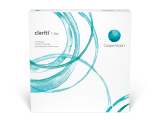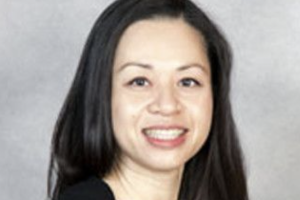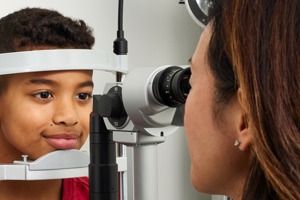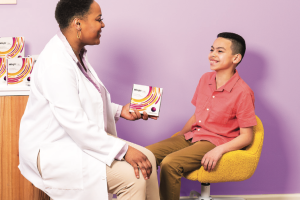Redmond Eye Clinic ECPs and staff share their top five on how to maximize the myopia visit.
When optometrist husband and wife duo Jeff Binstock and Kim Skyles discuss myopia management with their Redmond Eye Clinic team, their commitment to combat childhood myopia is so contagious, it overflows to their staff, and subsequently, every patient touchpoint of their practice.
Drs. Binstock and Skyles’ interest in myopia first ignited during their optometry school days at Southern California College of Optometry. After the couple purchased their Washington State practice five years ago, they integrated myopia management on day one and continue building on that momentum through the addition of new technology, including biometry, and evidence-based treatment. The key to their myopia management growth also encompasses staff training done on repeat, which can entail the practice manager giving frequent pop quizzes to techs during lunch breaks.
For Drs. Binstock and Skyles, the stakes are too high not to make myopia management a priority for all.
“In healthcare, doctors often wait to treat a condition until a patient becomes sick. We’re in a unique position with myopia management since we can prevent problems before they occur. You can’t prevent glaucoma, macular degeneration, or a retinal detachment caused by the eye becoming too large too quickly, but you can help prevent myopia progression,” Dr. Binstock explains.
Here, Dr. Binstock, Dr. Skyles, and Redmond Eye Clinic staff share their top five on how to elevate the myopia visit, connect with parents, and create a practice culture in which every team member embraces this important pediatric specialty.
1. Take the Plunge, Share Your Passion
Myopia management provides a niche opportunity for eye care professionals and especially optometrists, Dr. Skyles says. “If you’re interested in doing something meaningful and worthwhile, myopia management is probably the most significant area where eye doctors can have the most impact. Myopia management isn’t something most ophthalmologists do, and it isn’t something primary care doctors do. The future of myopic children’s eyes is mainly the responsibility of optometrists.”
At Redmond Eye Clinic, sharing one’s passion about myopia management is not reserved to the doctors. The clinic’s tech, Carly Clark, makes it a point to be upbeat in the exam room during every myopia office visit. “With kids, you need to get excited and stay excited,” she says.
For example, if a child is new to contact lens wear, they may be hesitant during CL insertion and removal training. “If you’re excited, the children will be excited, and the experience will turn into something exciting for them too.”
2. Pass the Baton with Confidence
After Carly greets the patient and their family in the lobby, she will escort them into the pre-testing area and measure the child’s axial length, a test that is performed on every pediatric patient, regardless of their refractive error. If a parent with an age-appropriate child expresses interest in a CL myopia treatment option, Carly will also perform corneal topography before she turns the families over to the doctor.
During each step of the visit, every member of the eyecare team communicates with the families, so parents have a firm understanding about their child’s condition and treatment options before they leave the practice.
“We explain why we do each test and what the tests will show us about their child’ eyes. Everyone in the practice has our myopia speech on lockdown. We explain what myopia is, what the child’s numbers show, what their projections could be, and treatment options,” Dr. Binstock says.
Following the exam, Drs. Binstock and Skyles will pass the baton to Carly or another staff member who will further discuss the practice’s myopia management program and review treatment costs.
3. Ensure the Team Speaks from the Same Playbook
Doctors and staff explain the potential consequences if the child’s myopia isn’t treated. However, these points are countered with a heavy dose of empathy, Dr. Skyles notes. “It’s easy to turn a parent off by telling them something bad is going to happen to their kid, and they’ll likely get defensive with this approach. We focus on what we can do to prevent progression.”
Adds office manager Nicole Costello, “We always put a positive spin on every step in the clinic. It’s important to talk about risks, but we also highlight the satisfying parts of treatment and the benefits of the program.”
During checkout, the tech or another staff member will review the results of the child’s projected axial length growth without treatment. “We reiterate what the doctor already discussed. We explain the basics of the program, and the treatment the doctor recommends. We also share examples of kids on treatment who’ve been very successful and happy with the results,” Nicole explains.
“We present treatment in a way where no treatment isn’t an option. We ask, ‘Which treatment are you going to choose, and which one is best for your family?’”
4. Consistent Follow-up Leads to a Strong Conversion Rate
Considering treatment options, Drs. Binstock and Skyles both prescribe MiSight® 1 day contact lenses, the first and only FDA-approved* soft contact lenses proven to slow myopia progression in children, aged 8-12 at the initiation of treatment.†1
Both doctors prescribe low-dose atropine. Dr. Binstock also offers orthokeratology, which is FDA approved for myopia management.
For parents not ready to commit to treatment at the consult, staff and doctors encourage these families to consider treatment further when they are at home. The practice has a built-in electronic health record task where staff will call the family one week later. During the call, staff will ask which treatment option the family selected.
“We present treatment in a way where no treatment isn’t an option. We ask, ‘Which treatment are you going to choose, and which one is best for your family?’” Dr. Binstock adds.
If a parent can’t be reached by phone at the one-week mark, staff will follow-up with a text or e-mail, a process that will be duplicated on week two if there is still no response.
This approach appears to be effective with families, since Redmond Eye Clinic’s conversion rate is approximately 70 percent.2
5. Train. Train. Repeat.
The key to staff training is “repetition, repetition, repetition,” Dr. Skyles says. Reinforcing the practice’s “Why” behind myopia management is instilled during regular staff meetings, along with benefits of the program, the latest myopia research findings, and best practices on communicating with parents.
The practice also follows “The Great Game of Business” philosophy, where employees are educated on the business end of the practice, take active roles in improving it, and have a stake in the outcome. Staff are also responsible for specific business line items, some of which pertain to myopia management.
Interspersed between the all-hands-on-deck staff meetings are one-on-one training and shadowing sessions with Nicole, who has a unique perspective, since she’s held previous roles at the practice including front office receptionist and tech.
On a typical day, techs will check in with Nicole on their lunch break, when they may receive a pop quiz on subjects such as pricing. Nicole will also roleplay with techs, posing as a parent with questions about treatment options and wearing schedules.
Final Thoughts
“I really believe myopia management should be standard of care,” Dr. Binstock says. “The days of, ‘You’re a myope, go get some glasses, and we’ll see you next year’ is over. Every optometrist can and should offer myopia management. You can start with very little equipment, and if you don’t feel comfortable treating children, refer to another OD who does. The stakes are too high not to act.”
*Indications for use in the U.S.: MiSight® 1 day (omafilcon A) soft (hydrophilic) contact lenses for daily wear are indicated for the correction of myopic ametropia and for slowing the progression of myopia in children with non-diseased eyes, who at the initiation of treatment are 8-12 years of age and have a refraction of -0.75 to -4.00 diopters (spherical equivalent) with ≤ 0.75 diopters of astigmatism. The lens is to be discarded after each removal.
†Compared to a single vision 1 day lens over a 3-year period.
1. Chamberlain P et al. A 3-year Randomized Clinical Trial of MiSight® Lenses for Myopia Control. Optom Vis Sci. 2019;96(8):556-567
2. Redmond Eye Clinic. Data on file, 2023.








